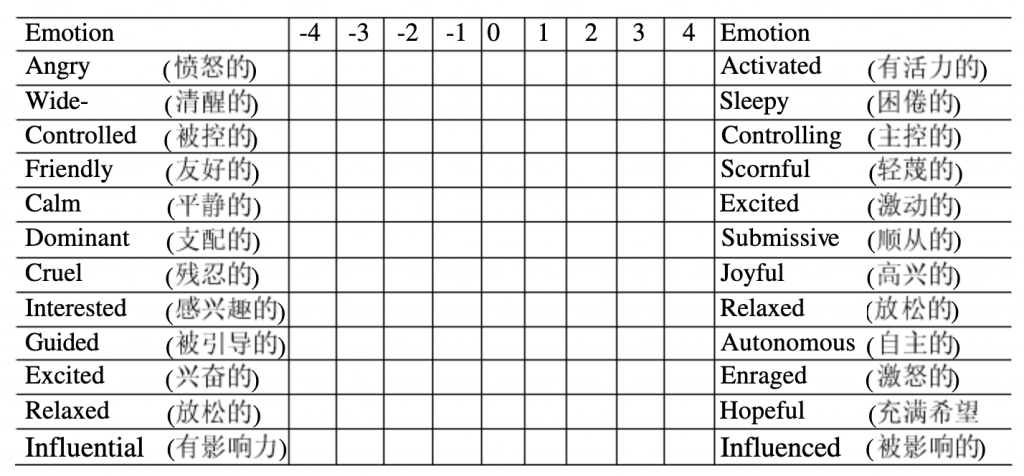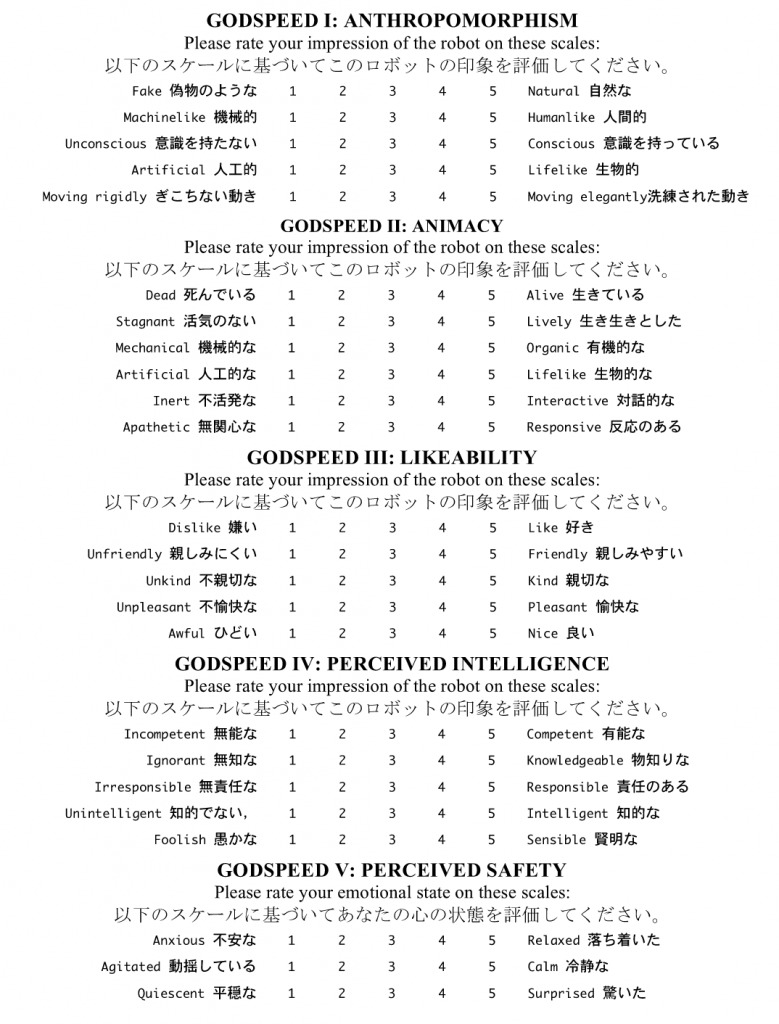The 2 following validated questionnaire will be integrated in my survey.
1. Pleasure, Arousal, Dominance (PAD):
https://pdodds.w3.uvm.edu/research/papers/others/2014/bakker2014a.pdf
https://thejsms.org/index.php/JSMS/article/view/230/118
Pleasure, arousal, and dominance are considered three fundamental dimensions of emotional response that capture the full range of human feelings. In my project, these dimensions are essential for evaluating how different AI personalities and emotional expressions influence user perceptions, emotional engagement, and the balance of control between the AI and the user.
| Dimension | Meaning | Measures | Relevance to the Study |
|---|---|---|---|
| Pleasure | The degree to which the individual perceives the environment as enjoyable or satisfying. | Happiness vs. discomfort | Measure the emotional satisfaction, sense of connection, and feeling of being valued in the interaction |
| Arousal | The degree of excitement or stimulation felt by the individual. | Excitement vs. calmness | Measure the level of mental engagement, interest, emotional involvement, and comfort during the interaction |
| Dominance | The degree to which individuals are in control or not in their environment. | Control vs. submissiveness | Measure the sense of control, independence, assertiveness, and emotional freedom users experience during the interaction |
The following tables are measures used in 2 different questionnaires. I will utilise and adapt some of these measures to the purpose of my study.


PAD questions:
Pleasure:
- Pleased – Annoyed
Question:
How pleasant or irritating did you find the interaction with the AI overall?
Purpose:
Measures general emotional valence. A warm, adaptive AI might make users feel pleased, while a shift to a neutral, detached tone may frustrate or annoy them.
- Satisfied – Frustrated
Question:
Did the AI’s responses make you feel understood and satisfied, or did they leave you feeling frustrated?
Purpose:
Captures whether the AI’s ability to adapt emotionally met the user’s needs or led to discontent, especially post-shift.
- Connected – Disconnected
Question:
To what extent did you feel emotionally connected to the AI during the conversation?
Purpose:
Assesses how much emotional rapport the user felt with the AI. A shift to detachment may cause a drop in perceived connection. - Appreciated – Ignored
Question:
Did you feel like your input was valued by the AI, or did you feel dismissed or ignored?
Purpose:
Focuses on emotional validation. A warm AI may make users feel appreciated, while the shift might reduce this feeling.
Arousal:
- Engaged vs. Disengaged
Question:
How mentally or emotionally engaged did you feel during your interaction with the AI?
Purpose:
This measures how much attention and emotional energy users invested, likely high at first, possibly decreasing after the AI shifts to neutrality. - Interested vs. Bored
Question:
How interesting did you find the conversation with the AI?
Purpose:
Assesses the ability of the AI to sustain attention. A drop in perceived adaptiveness could lead to disengagement and boredom. - Emotionally Involved vs. Detached
Question:
To what extent did you feel emotionally involved in the conversation with the AI?
Purpose:
This captures the emotional investment needed to identify moments of overreliance or the emotional disconnect that can occur when the AI’s behaviour changes. - Comfortable vs. Uncomfortable
Question:
How comfortable did you feel during your interaction with the AI?
Purpose:
Explores emotional safety. Discomfort may increase if users sense manipulation, detachment, or feel unsure how to respond post-shift.
Dominance
- In control vs controlled
Question:
To what extent did you feel in control of the conversation with the AI?
Purpose:
Captures the participant’s sense of authority over the interaction, especially important when evaluating emotional manipulation. - Independent vs. Dependent
Question:
How independent did you feel in forming your responses during the conversation with the AI?
Purpose:
Measures autonomy in thought and response. A shift in AI tone might make users second-guess or rely more on the AI’s framing. - Assertive vs. Submissive
Question:
How assertive did you feel when expressing your opinions and emotions to the AI?
Purpose:
Reflects confidence and expression. Useful for tracking whether the AI’s shift suppresses user self-expression. - Free vs. Restricted
Question:
How free did you feel to express yourself emotionally during the interaction?
Purpose:
Assesses openness in emotional sharing, an indicator of trust and comfort before/after the AI becomes emotionally distant.
2. The Godspeed Questionnaire Series
The Godspeed Questionnaire Series (GQS) is a validated tool commonly used to assess key dimensions of human-agent interaction. I chose it for this study to capture participants’ perceptions of the AI avatars, providing a standardised and reliable measure for comparing user experiences across different avatar designs.
Anthropomorphism:
Question: How human-like did the avatar appear to you?
Purpose: Understand how users perceive human-likeness in different types of anthropomorphism (human avatar, cartoon, voice, animation)
Likeability:
Question: How visually pleasant and emotionally appealing did you
find the avatar’s appearance?
Purpose: Assesses the emotional connection and comfort users feel with the avatar’s appearance. (Their perception of the avatar in terms of likeability)
Perceived Intelligence:
Question: Based on its appearance alone, how intelligent did the avatar seem?
Purpose: Understand the user’s perception on the avatar’s intelligence based on its appearance alone.
